
|
Today we announce the adaptation of Capebities for Amazon Nova in Amazon Sagemaker AI. Customers can now adapt Nova Micro, Nova Lite and Nova Pro throughout the model’s life cycle, including pre -training, under the supervision of fine fine -tuning and alignment. These techniques are available as recipes for Amazon Sagemaker with ready to use with trouble -free deployment to Amazon Bedrock, which supports both on request and commission permeability.
Amazon Nova Foundation Power models use various generative AI Casses across industries. Since customers of a range of deployment need models that reflect ownership, workflows and brand requirements. To integrate the models of a general-purpous foundation into applications, fasting and generation search (RAG) works well.
Choosing the right technical adaptation
The Amazon Nova models support a number of technical adaptations including: 1) under the supervision of fine fine -tuning, 2) alignment, 3) continuing pre -training and 4) knowledge distillation. The optimal choice depends on the targets, the complexity of the case of use and the availability of data and the calculation of resources. You can also combine multiple techniques to achieve your desired results with a preferred combination of performance, cost and flexibility.
Overseeed fine fine -tuning (SFT) It adapts the model parameters using the PEIR input output data set specific to your target tasks and domains. Select from the following two implementation approaches based on data and cost volume:
- Fine fine -tuning (PEFT) -It only fits a subset of model parameters through light adapter layers, such as Lora (low value adaptation). It offers faster training and lower calculation costs compared to complete fine -tuning. NOVA models adapted to PEFT are imported into Amazon Bedrock and induced by inference.
- Complete fine -tuning (FFT) – updates all model parameters and is ideal for scenarios if you have extensive data sets (tens of thousands of records). Novo models adapted through FFT can also have Amazon Bedrock and evoke to a conclusion with the permeability provided.
Alignment It controls the output of the model towards the required preferences for the needs and behavior of the product specific, such as the requirements for the company brand and customer experience. These preferences can be coded in several ways, including empirical examples and police. Nova models support two preference leveling techniques:
- Optimization of direct preference (DPO) – offers a direct way to tune the outputs of the model using preferred/not preferred Peir responses. DPO learns from comparative preference and optimization of outputs for subjective requirements such as tone and style. The DPO offers both the effective parameter and the full model version. The version effective parameters support inference on request.
- Optimization of the proximal policy (PPO) – Strengthening learning that increases the behavior of the model optimization for the required rewards, such as usefulness, safety or commitment. The reward model leads optimization by optimizing output scoring and helps the model to learn effective behavior while maintaining previously learned skills.
Continuing pre -training (CPT) It extends the knowledge of the basic model through a separate adolescent learning about a large number of unmarked proprietary data, internal internal documents, transcripts and content specific to business. CPT attacked SFT and alignment via DPO or PPO provides understanding the way of adapting new models for your applications.
Knowledge of knowledge It transmits the knowledge of the large model of the “teacher” to a smaller, fast and more cost -effective “student” model. Distillation is useful in scenarios where customers do not have sufficient samples of reference input-access and can use a more powerful model to increase training data. This process creates adapted accuracy model at a teacher level for specific cases and cost efficiency and speed at the level of students.
Here is a table summarizing its own techniques across different modalities and deployment options. Each technique offers specific training and inferring capacitors depending on your implementation requirements.
| Recipes | Modality | Training | Derivation | ||
|---|---|---|---|---|---|
| Amazon Bedrock | Amazon Sagemaker | Amazon Bedrock on-Demand | Amazon Bedrock provided permeability | ||
| Under the supervision of fine tuning | Text, picture, video | ||||
| Fine fine -tuning (PEFT) | ✅ | ✅ | ✅ | ✅ | |
| Tuning | ✅ | ✅ | |||
| Optimization of direct preference (DPO) | Text, picture | ||||
| Parameter -FFECT DPO | ✅ | ✅ | ✅ | ||
| The entire DPO model | ✅ | ✅ | |||
| Optimization of the proximal policy (PPO) | Only the text | ✅ | ✅ | ||
| Continuous pre -training | Only the text | ✅ | ✅ | ||
| Distillation | Only the text | ✅ | ✅ | ✅ | ✅ |
Early access customers, including Cosine AI, Massachusetts Institute of Technology (MIT) Computer Science and Artificial Intelligence Laboratory (CSail), Volkswagen, Amazon Customer Service and Amazon Catalog Systems Service.
Customize Novo Models in Action
The following goes through an example of Nova Micro’s adaptation by optimizing direct preference on an existing data set of preferences. If you want to do it, you can use the Amazon Sagemaker Studio.
Start your Sagemaker studio in the Amazon Sagemaker AI and choose JumstartMachine learning hub (ML) with foundation models, built -in algorithms and pre -created ml solutions that you can deploy several clicks.
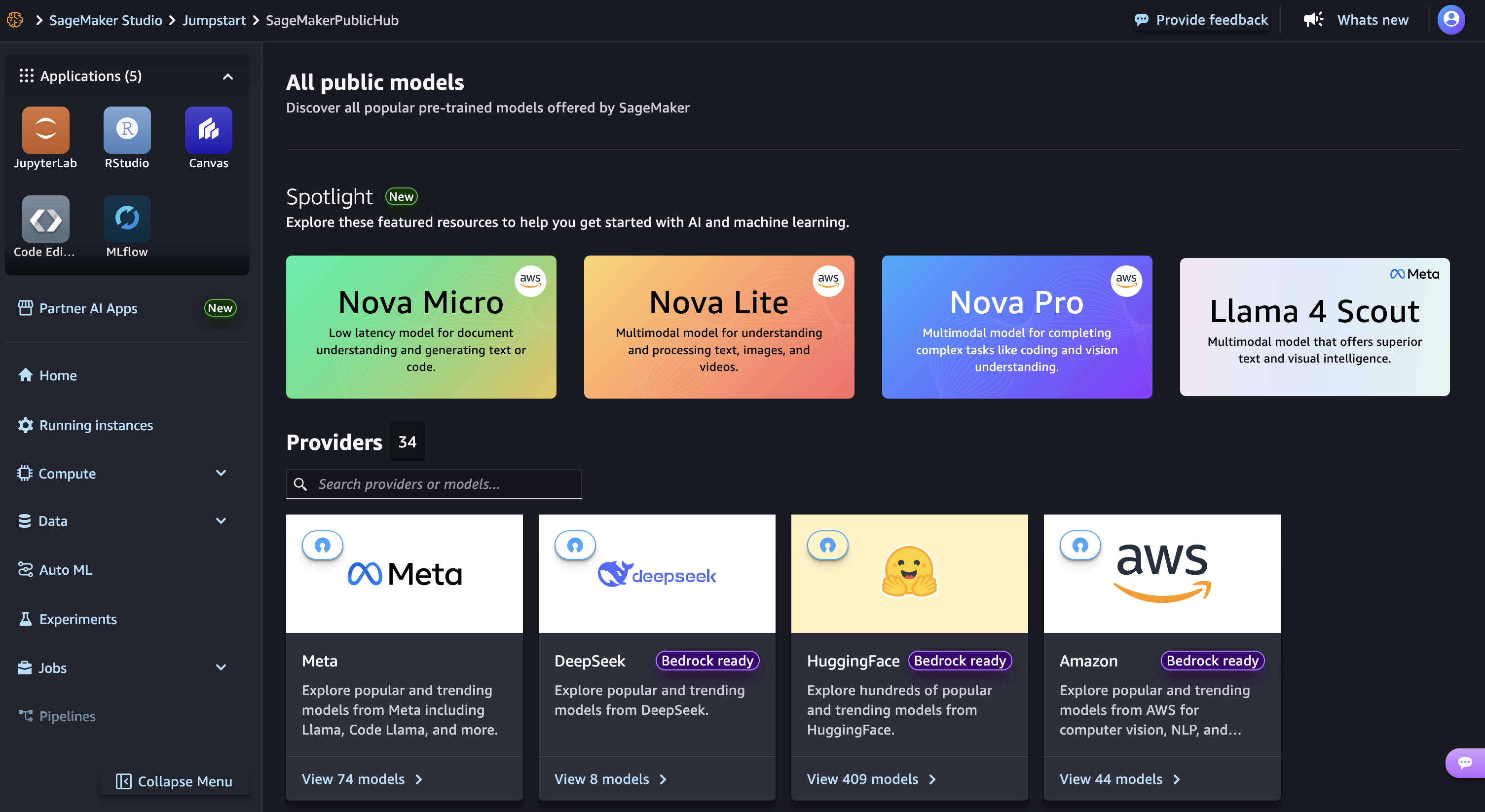
Then choose Nova microModel only for text that provides the lowest latency responses for the lowest cost of inference between the Nova Model Family, and then select Train.
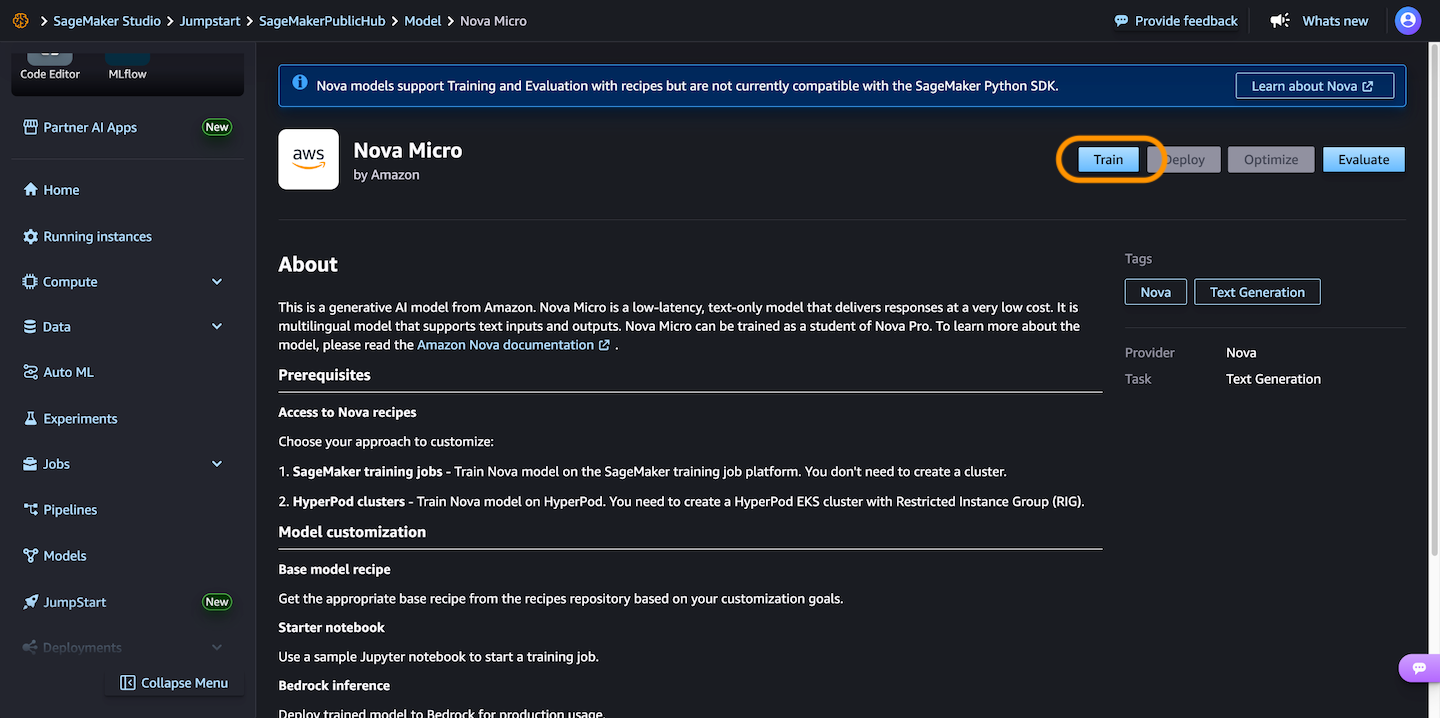
You can also choose a gentle tutoring Recipe for training model with marked data to increase performance on specific tasks and alignment with the desired behavior. Selection Optimization of direct preference It offers a direct way to tune the model outputs using your preferences.
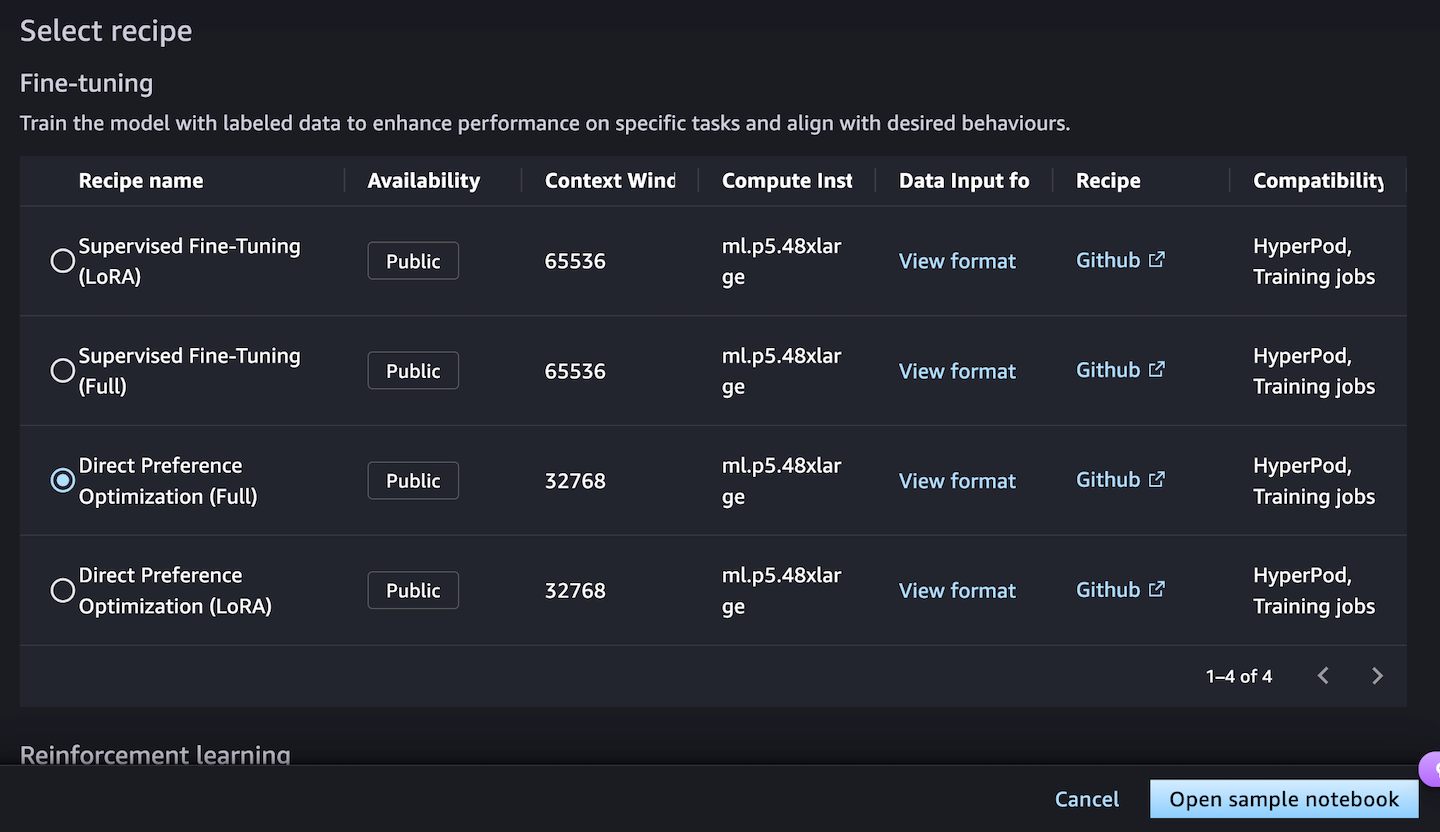
When you decide An open sample notebookYou have two options to run the recipe: either for Sagemaker or Sagemaker Hyperpod:
Choose Start the recipe Sagemaker Training Jobs If you do not have to create a cluster and train the model using a sample notebook by selecting JupyterLab space.
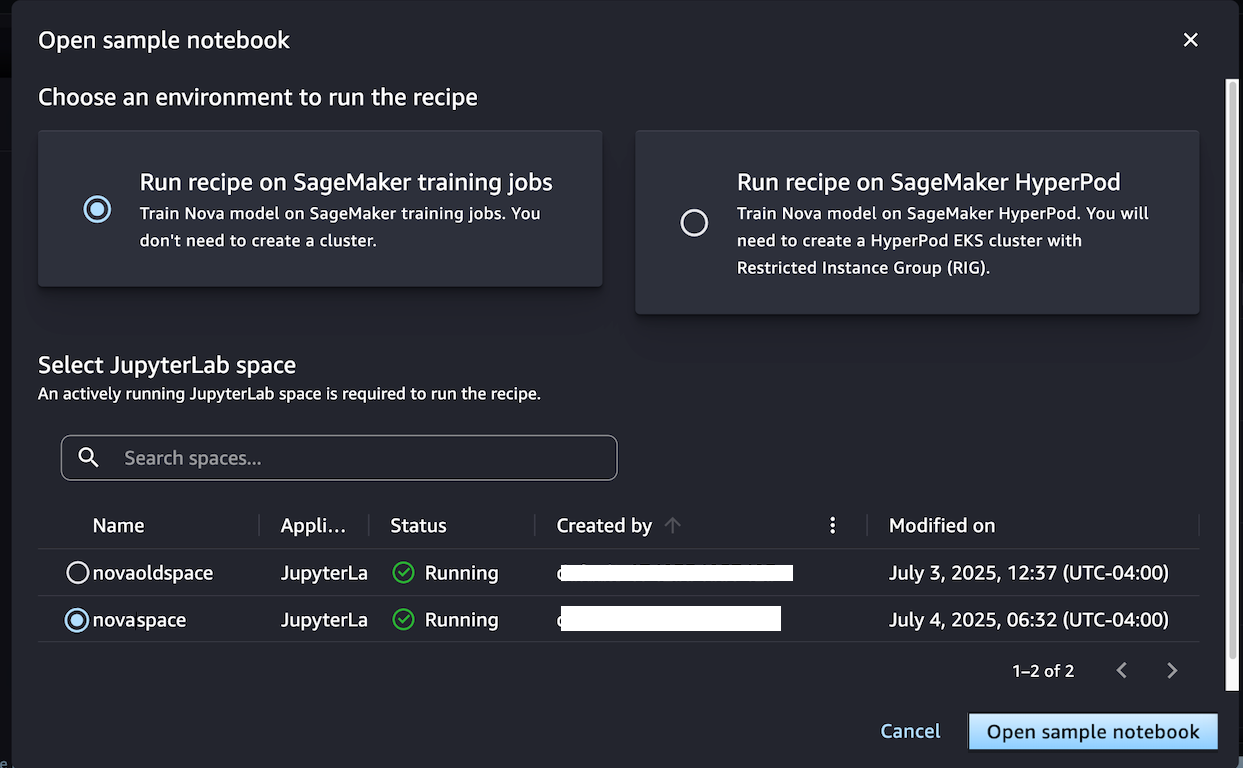
Alternatively, if you want to have optimized cluster for the iterative training processes, choose, choose, choose Start the recipe for Sagemaker Hyperpod. You can choose the Hyperpod ECS cluster with at least one group of limited instances (RIG) to provide a specialized isolated environment that is required for such training NOVA model. Then select your Jupyterlabspace and An open sample notebook.
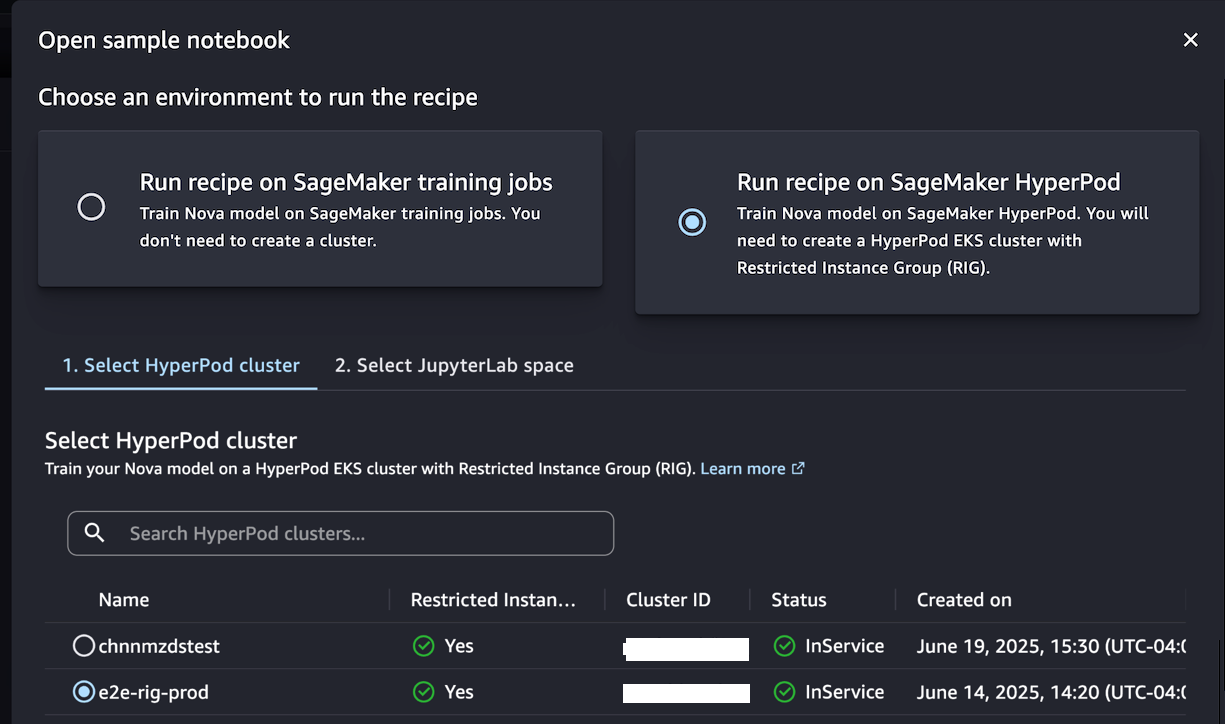
This notebook provides the end pass open to create a Hyperpod Sagemaker task using the SageMaker Nova with a recipe and to the conclusion. With the Sagemaker Hyperpod recipe, you can streamline comprehensive configurations and smoothly integrate data sets for optimized training.
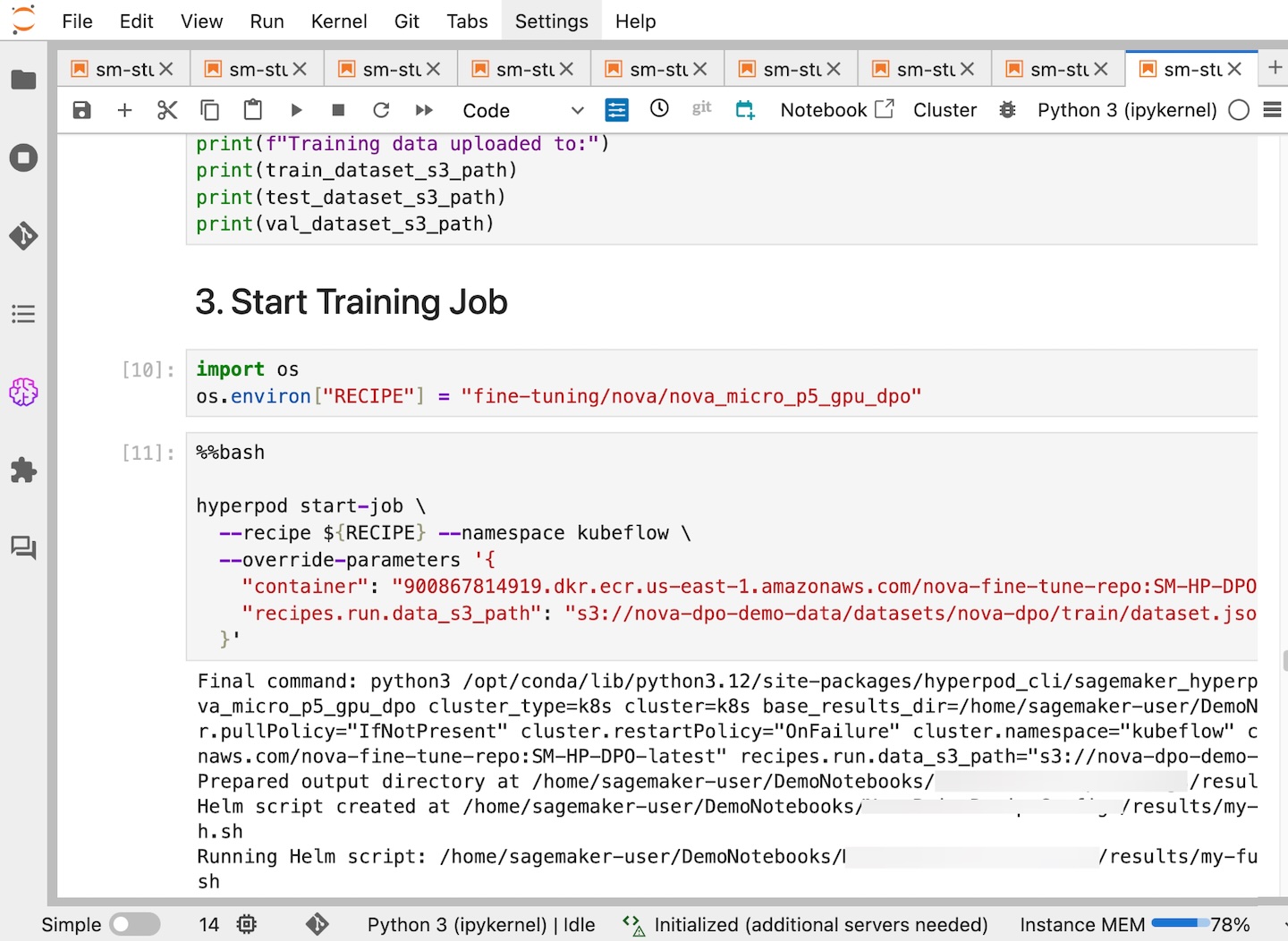
At Sagemaker Studio you can see how your work Hyperpod Sagemaker Hyperpod has been successfully created and you can follow it for further progress.

When you complete the task, you can use recipes for the recipe to evaluate whether the adapted model works better with the agent tasks.
Understanding documentation and other examples of implementation visit the recipe Hyperpod Sagemaker Recoven to Github. We continue to expand the recipes based on customer feedback and the emerging ML of trends, ensuring that you have tools for successful AI.
Availability and start
Recipes for Amazon Nova for Amazon Sagemaker AI are available on US East (N. Virginia). For more information about this feature, visit the Amazon Nova and Amazon Nova website and start in the Amazon Sagemaker AI Console.
–Betty
Updated July 16, 2025 – Revised Table Data and Console Screen.

